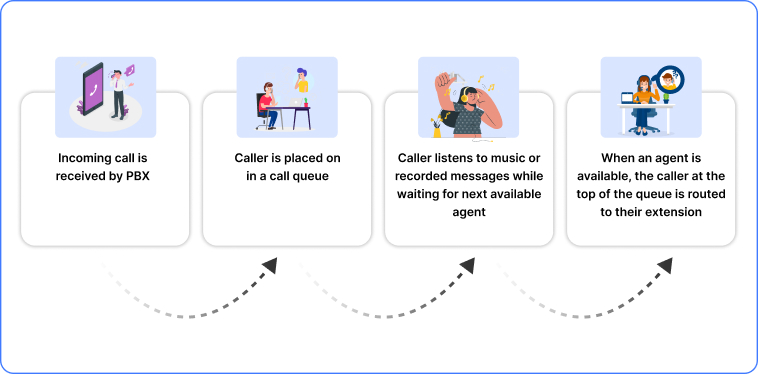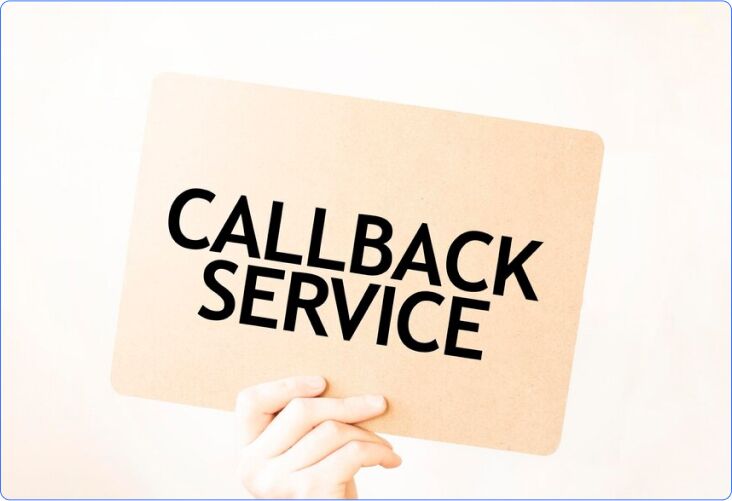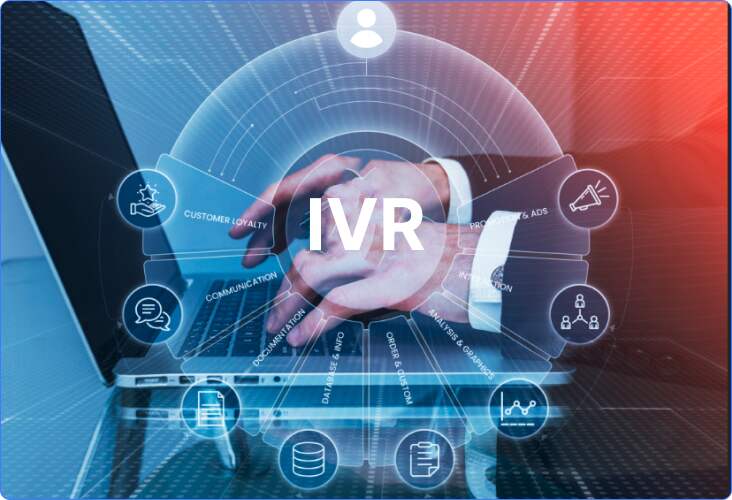
While profit is essential, what is the deeper purpose that drives business? It’s surely creating a loyal base of happy and satisfied customers. There are many tools and techniques that can help improve customer service. Call queuing technology is a popular option for businesses looking to streamline their callers’ phone interaction experience.
While 60% of customers prefer human interaction when contacting a business, how can a business with limited agents or high call volumes ensure that customers don’t hang up, especially during peak hours?
Call queuing is the solution to this problem. In this comprehensive guide, I will explain why call queuing is an important part of your business call center. Also, we will delve into the different types of call queues that you can implement, along with some really useful practices for call queue management.
Let’s learn!
What is a Call Queue?

A call queue is a virtual waiting room for callers who call your business phone number. It is normal for a call center setup to have multiple callers waiting in call queues trying to get through to an agent, department, or team. Call queues ensure a fair, engaged, and orderly wait for callers so that everyone gets their turn to interact with a live agent.
“Nearly three out of five consumers report that good customer service is vital for them to feel loyal toward a brand.” (Zendesk)
Simply put, a call queue is a feature of business phone systems that directs callers into a virtual waiting line based on some pre-defined criteria and keeps them on the queue unless an agent becomes available to take the call. This process is called call queuing.
Usually, a call queue is a feature of a phone system or call center software. Many business phone systems and call center software come with built-in call queuing capabilities.
How Call Queuing Works?

Contact centers and customer service operations use call queuing to ensure a smooth flow for both callers and agents. Here’s a breakdown of the key steps:
Incoming Call Arrives
As the incoming call arrives on your business phone system, the auto attendant or automated attendant greets the caller. The greeting usually includes information about the business, such as standard business hours and the availability of the agents. If an agent is not available to take the call, the caller is directed to the call queue and informed about the same by the auto attendant.
Call Queue Management
The call queue management system in your business phone manages the calls in the queue based on pre-defined rules. It considers factors like the arrival time of the call, the status or priority of the customer, the expertise of the agents, the urgency of the query, etc. These rules can be configured as per the needs of the business.
For instance, if the customer who just called is a VIP customer, then he may skip the queue and connect directly to a dedicated agent for VIP customer handling.
Hold Time
During the hold time, callers remain in the waiting queue and may hear music or on-hold messages such as estimated wait time, current offers and discounts, etc. This keeps callers engaged and lessens their frustration due to idle waiting or no clue about when they will be connected to an agent.
Agent Allocation
As soon as an agent becomes free to take the call, the business phone system connects the caller with the currently available agent. The agent then assists the customer with their query.
Types of Call Queues
There are several arrangements in which call queues are managed. You can choose call queues for your business depending on your specific needs and goals:
-
Linear Call Queue
The logic behind the linear call queue is very simple and straightforward. It works on a first-come-first-serve basis. This means that the caller who called up first and is the first one in the call queue will be the first to be connected to an available agent. In other words, calls are answered in the order they are received. Well, that seems like a fair way to handle customer calls, isn’t it?
Pros: Not much configuration is required to set up a linear call queue because it is easy to understand and manage.
-
Circular Call Queue
Circular call queues work in a continuous loop, i.e., when an agent completes a call, he is placed at the bottom of the call distribution list. The circular nature of these call queues ensures that agents who have just taken a call get time to wrap up and prepare notes.
Pros: Teams with agents having similar skills and expertise can benefit from circular call queues, as agents will receive an equal number of calls.
-
Priority-based Call Queue
As the name suggests, priority-based call queues give higher priority to certain types of callers based on some pre-defined rules or criteria, such as VIP customers or urgent queries. High-priority calls are moved to the front of the queue or directed to the most skilled agents.
Pros: Priority call queues can be leveraged as your business’s USP, offering immediate attention to sensitive and valued queries.
-
Skills-based Call Queue
In skills-based call queues, calls are routed based on the specific skills or expertise of agents. It ensures that the caller is connected to an agent best suited to handle their particular issue. Here, the skills of the agents are assigned in the backend so that customer calls are directed based on the skill required to solve their query.
Pros: Skills-based call queues can significantly improve the FCR rate, i.e., the first call resolution rate. It’s an important metric in call centers that defines the ability of the agents to meet customers’ needs fully on their first call itself.
Useful Call Queuing Features
Call queues come packed with various features that benefit everyone involved. Let’s explore these features, one by one:
Call Queue Features for Callers

-
Estimated Wait Time and Queue Position Announcement
With this feature of call queues, you can keep callers informed about their expected wait time and their position in the call queue. The system makes periodic announcements about the time for which the caller needs to wait before they can talk to a live agent.
A simple example would be like this: “Thanks for calling ABC Company. Your call is important to us. You are currently number 3 in the queue. Your estimated wait time is 2 minutes.”
This ensures that callers do not wait cluelessly in silence; rather, they get an update about their estimated time, which reduces frustration.
It is important to note that estimated wait times are just an approximation. The actual wait time may be shorter or longer, depending on various other parameters.
-
Callback Facility and Leave a Message

By using the callback option, your callers can request a callback instead of waiting on hold. This feature is very useful for those who do not wish to wait in the queue and are comfortable receiving the required assistance later. Otherwise, they also have the option to leave a voice message, which agents can act on accordingly.
-
Interactive Voice Response (IVR) Menus
Before a caller reaches a live agent, IVR can be used to offer self-service options and automate simple tasks like account balance checks or password resets. This helps free up agents for more complex inquiries and provides customers with faster responses to their questions or queries. If the caller doesn’t wish to self-service, the IVR directs them to the most suitable agent as per their query.
-
Music on Hold
As the term suggests, the music on hold feature plays prerecorded music for the callers who are waiting in a call queue. Rather than complete silence, callers get to hear some music along with periodic announcements about their queue position and wait time. It helps keep the callers engaged and also reduces their frustration.
Call Queue Features for Agents

Automatic Call Distribution or ACD
ACD, which stands for Automatic Call Distribution, is the technology that works behind the scenes to route incoming calls within a call queue. The ACD system works on predefined rules or factors such as business hours, agent availability, agent skills, IVR selections, etc. So when a customer calls your business, the call is directed to the ACD system, which usually has the following methods of working –
- Fixed Order
Calls are routed based on a pre-configured hierarchical order.
- Talk-Time Based
Calls are directed to the agent with the least amount of talk time, ensuring a balanced workload distribution.
- Uniform
The agent who has been idle the longest receives the next call, promoting fair call distribution.
- Round Robin
Calls are assigned sequentially to agents in a fixed order (e.g., the first call goes to agent one, the second to agent two, and so on).
- Simultaneous Ringing
All agents’ phones ring simultaneously, minimizing the average time to answer.
Queue Whisper or Pre-Call Information
Before an agent is connected to a caller, the system provides the agent with information relevant to the customer. This usually includes past interactions and account details. This gives agents an estimate of who they are going to interact with and what they can expect during the call. Ultimately, it helps agents offer more personalized service to callers.
Call Queue Features for Managers

-
Real-time Queue Monitoring
It’s like having a bird’s-eye view of crucial call metrics such as call volume, agent availability, and average wait time. With real-time data at your fingertips, you can make informed decisions such as moving inactive agents to current call queues and playing customized hold announcements when waiting time gets extended or delayed.
-
Post-Call Surveys
Practically, it is impossible to collect feedback during the call, every single time. Post-call surveys are a valuable tool for collecting insights from customers. Customers can choose from multiple options, give star ratings, or leave their comments to communicate about their call experience.
-
Call Recording & Quality Monitoring
Every interaction between a customer and your agent is like a story that tells about the customer’s experience and your agent’s performance. By recording, listening, and reviewing the calls, you can assess the communication skills of the agent as well as any areas for improvement.
How to SetUp Call Queue? 5 Simple Steps
1. Choose Your Call Center Platform
To set up call queues for your business, it is recommended to have a dedicated call center platform that offers call queue functionality. You can check with your current provider (if you have one) or explore various options available in the market.
2. Define Your Call Queues
Create a clear name for your call queues, ensuring that the name reflects the purpose of the queue. A simple example is the Technical Support Queue.
3. Select and Assign Agents
Next, you can simply select the agents who will be handling calls within the queues. A good way to start is by creating groups of agents with similar skills. So a call with a query regarding billing will go to any agent in the billing expertise group.
4. Setup Your Interactive Voice Response or IVR
An IVR system is usually the first point of contact when a customer calls your business. It allows you to record an automated greeting and menu that your customers will be presented with.
Make sure the automated greeting is not just a generic tagline; rather, try to provide some information about your business. Also, ensure that it quickly communicates the available options to callers. For example, press 1 to connect with the billing department.
5. Configure Call Queue Settings
An important step while setting up your call queues is selecting a piece of calming and professional hold music to keep callers from hanging up in frustration. Another crucial thing is to provide callers with a Callback option so that those who do not wish to wait in the call queue can request a callback.
Causes Behind Long Call Queues and Wait Times

Every technology comes with some pros and cons. While we have learned about the advantages offered by call queueing, shall we now get to the other side, i.e., the problems associated with call queues? Long call queues are often a real pain for both callers and businesses. Often, callers hang up after getting frustrated when they have to wait in long call queues. Let’s understand the main culprits behind those lengthy call queues:
High Call Volume
This is quite an obvious one. If your business experiences a sudden spike in calls, like during peak hours, promotions, or festival season, your phone lines might get overwhelmed, and queues can back up.
Understaffing
Not having adequate agents in your customer care department to handle call volume often leads to long call queues. It’s important to have sufficient staffing levels, especially during peak times, to ensure calls are answered promptly.
Inefficient Routing
No matter how many agents you have, if your routing system is poorly designed, it is not going to help you. If incoming calls aren’t directed to the most appropriate agents or get stuck in loops, it can create bottlenecks, slowing things down and lengthening wait times.
Lack of Self-Service Options
Again, if your business phone system offers customers limited options for answering their questions outside of calling, like routine or basic information access through an auto attendant, a comprehensive FAQ section, or chatbot support, they’ll be more likely to flood the call queue with basic inquiries.
What is Call Queue Management and Why is it Important?
Call queue management consists of the steps taken for the strategic organization of incoming calls. It makes sure that incoming calls are routed to the right agent at the right time while ensuring the efficient utilization of resources. Ultimately, the goal is to keep both customers and agents happy. There are several reasons that make call queue management an important process for call centers, which are:
Reduced Wait Times

Effective call queue management ensure calls are distributed efficiently, minimizing the time customers spend on hold. This translates to happier callers, less frustration, and a more positive perception of your business.
Interesting Insight: The industry standard for call center average wait time is often set at around 20 seconds, with the goal of answering 80% of calls within this timeframe.
Improved First Call Resolution Rates
According to industry standards, the average FCR rate in the contact center industry is around 70-75%.
A high FCR rate is often linked with higher rates of customer satisfaction. By effectively routing calls to skilled agents based on their needs, call queues increase the likelihood of issues being resolved on the first call. This saves customers time and frustration and reduces the need for repeat calls.
Interesting Insight: To calculate the FCR rate, you divide the total number of calls or support requests that were successfully resolved on the first attempt by the total number of received cases.
Reduced Stress and Workload
According to a survey, as many as 74% of contact center agents are at risk of burnout (source).
Effective call queue management distribute calls fairly among agents, preventing any one agent from being overloaded. This creates a less stressful work environment and allows agents to focus on providing quality service.
Increased Productivity
Reduced hold times and efficient call distribution lead to increased agent productivity. They can spend more time resolving customer issues and less time managing overflowing queues.
Improved Customer Satisfaction
Happy callers translate to loyal customers. Reduced wait times, efficient service, and first-call resolution all contribute to a more positive customer experience, which is key to business success.
Cost Savings
According to Hubspot, typical Call Abandonment Rates are between 5 and 8%, and 80% of calls are answered within 20 seconds.
Efficient call center operations can lead to cost savings. Reduced call abandonment rates, improved first-call resolution, and optimized agent productivity all contribute to a more cost-effective call center.
Call Queue Management Best Practices
Suppose you called a business needing help from them, only to press buttons, navigate menus, and repeat information – feeling like getting lost in circles.
Long call wait times can easily turn your happy customers into frustrated ones. Proper call queue management can lead to faster resolution rates, more chances to close deals, and improved customer satisfaction. It can also decrease customer churn and employee turnover. Here are some of the best practices you can implement in your call queue management:
Master the Art of Scheduling
A major problem that affects the quality of your customer service is the unavailability of agents during high call volume periods. By analyzing the past call data, you can identify peak hours and schedule additional agents for these periods to maintain a smooth call flow. This keeps wait times low and agents from feeling overwhelmed.
Craft Crystal-Clear Greetings and Announcements
One of the best practices to make sure that callers don’t hang up while on hold is to set up their expectations. Inform them about their estimated wait time and available hold options like callback and voicemail. This helps build transparency, and trust and reduces frustration among the customers.
Leverage the Power of IVR (Interactive Voice Response)
The biggest benefit offered by IVRs is that they allow callers to resolve simple issues like checking account balances. This eliminates the need for callers to speak with an agent, thus saving time for both callers and agents.

IVRs also prevent callers from having to repeat information to multiple agents. Collecting information about the caller, such as contact details, the desired department or agent, and the reason for the call, enables agents to review customer history for more informed interactions.
Provide your Callers with a Clear Exit/Escape
An important point to keep in mind while designing your call queues is to ensure that you respect your callers’ time. If they are not ready to wait, you should give them the option to leave a voicemail. Besides, that, you can offer self-service options and alternative contact methods such as email, and website, so they don’t leave clueless.
Embrace the Power of Callbacks
Callbacks are a great way to offer callers an alternative to waiting on hold and to make them feel valued. This empowers your callers to continue with their day while still receiving the assistance they need.
Implement Varied Routing Strategies
Earlier in this post, we discussed some of the most popular call queues that work on different types of call routing strategies.
To truly enhance your call queues, avoid using a single strategy for all business phone numbers or extensions. Instead, implement multiple call routing options tailored to different departments, current call volumes, agent schedules, VIP customer status, and more.
For this type of implementation, you need to analyze which routing strategies are most effective for specific situations. Also, you will need to regularly update these strategies to align with evolving customer expectations.
Invest in Regular Training Sessions
Conducting training sessions for your agents at regular intervals is quite an underrated practice that holds immense value. With a pool of well-trained agents, you can strategically assign calls based on their specialization. It also allows you to diversify agent skills and confidently assign more calls, leading to shorter wait times, especially for complex or intricate queries.
Types of Companies That Should Be Using Call Queuing
Call queues are beneficial for a wide range of businesses. Here are some types of companies that can see particular advantages:
- Companies that receive a high volume of incoming calls, such as customer service centers
- Businesses with fluctuating call volume, i.e., significant peaks such as a surge in calls during holidays
- Service-oriented businesses that rely heavily on providing quick and efficient customer service, such as banks, and insurance firms
- Businesses with 24/7 operations, i.e., companies that operate around the clock or cater to a global audience
Summary
In conclusion, call queues are a powerful tool to transform your phone lines from a potential source of frustration into a well-oiled customer service machine. By minimizing wait times and ensuring efficient call handling, call queuing management empowers businesses like yours to deliver exceptional customer service.
So, the next time your business gets overwhelmed with a high call volume, you know to embrace the power of call queues.




























